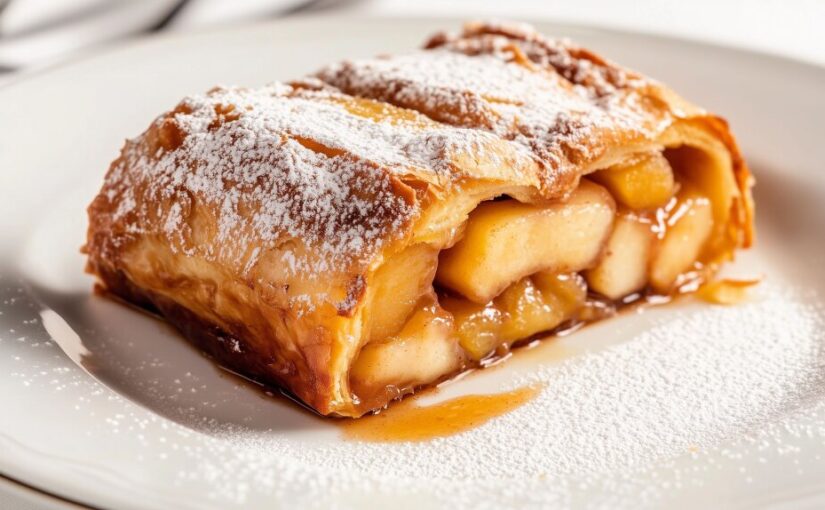Golden, warm, and fragrant with cinnamon, Apfelstrudel is a dessert that feels like a hug on a chilly afternoon. People love it because it brings together crisp, flaky pastry with a spiced apple filling that melts in your mouth. Whether enjoyed with a scoop of vanilla ice cream, a generous dollop of whipped cream, or simply dusted with powdered sugar, this Austrian classic has a way of instantly transporting you to a quaint alpine café.
Ingredients 🛒
- 500 g apples (preferably tart, such as Granny Smith)
- 100 g sugar
- 60 g raisins (optional, but traditional)
- 1 teaspoon ground cinnamon
- ½ teaspoon lemon zest
- 50 g chopped walnuts or almonds
- 100 g breadcrumbs
- 75 g butter, melted
- 1 sheet strudel dough or phyllo pastry
- Powdered sugar, for dusting
Preparation 🍽️
- Preheat oven to 180°C (350°F).
- Peel, core, and slice the apples thinly, then mix with sugar, raisins, cinnamon, lemon zest, and nuts.
- In a small pan, toast breadcrumbs in a little butter until golden. Let cool, then stir into the apple mixture.
- Lay out the strudel dough (or several layers of phyllo pastry brushed with butter). Place the apple filling along one edge.
- Roll up carefully, tucking in the sides, then brush the outside with melted butter.
- Transfer to a lined baking tray and bake for 35–40 minutes until golden brown.
- Let cool slightly before dusting with powdered sugar.
Serving Suggestions 🍨
Enjoy Apfelstrudel warm with vanilla ice cream, whipped cream, or a drizzle of vanilla custard. A cup of strong coffee or spiced mulled wine pairs beautifully with the sweet and tart flavors.
A Taste of History and Tradition 🏔️
Apfelstrudel is not just a dessert, it is a symbol of Central European cuisine and hospitality. First documented in Vienna during the 17th century, it quickly became a staple in Austrian coffee houses, where freshly baked strudels were served alongside steaming cups of strong coffee. The dish reflects a fascinating blend of cultures. Its delicate pastry was inspired by Ottoman baklava traditions, which traveled through Hungary into Austria. Over time, the Austrian bakers refined the technique, creating the paper-thin strudel dough that became a hallmark of the dish.
Strudel soon spread beyond Austria and was embraced in the kitchens of Germany, Hungary, and the Czech lands. Families often prepared it on Sundays and special holidays, filling kitchens with the irresistible aroma of apples, cinnamon, and butter. Traditionally, stretching strudel dough was seen as a test of a baker’s skill, since it had to be so thin that one could read a newspaper through it. Today, many home bakers use phyllo pastry for convenience, but the spirit of the tradition remains alive.
Apfelstrudel carries with it centuries of shared history, mingling peasant resourcefulness and imperial sophistication. When you enjoy this dessert, you taste more than just apples and pastry, you bite into a story of cultural exchange, festive gatherings, and simple pleasures that warm both heart and home.
Image by Marco Verch 👨🍳.
